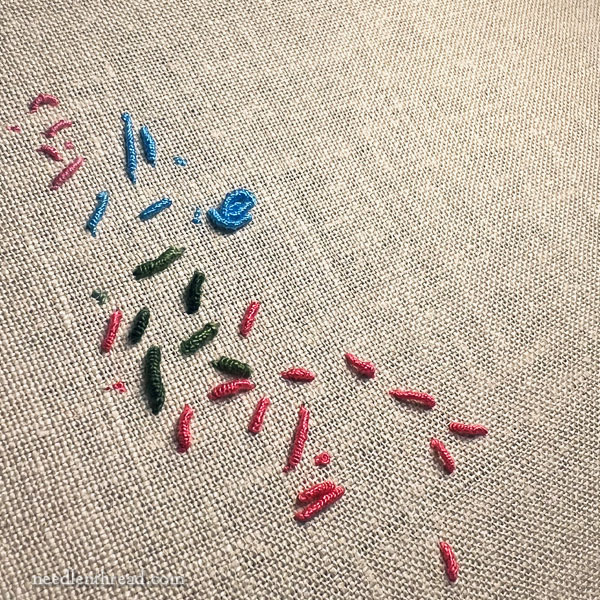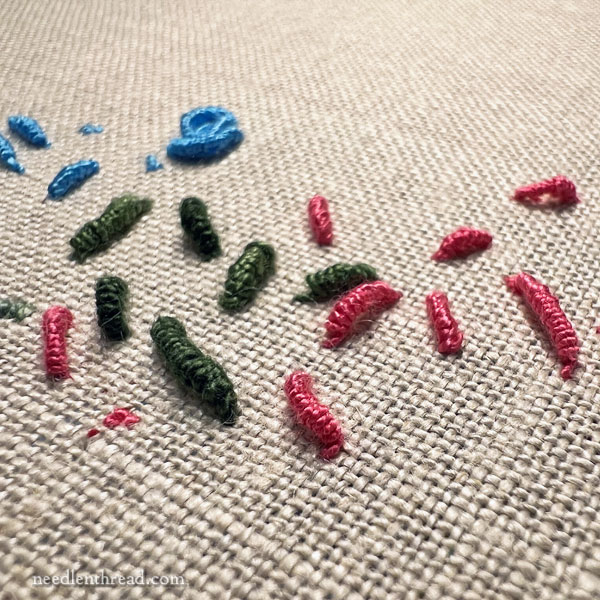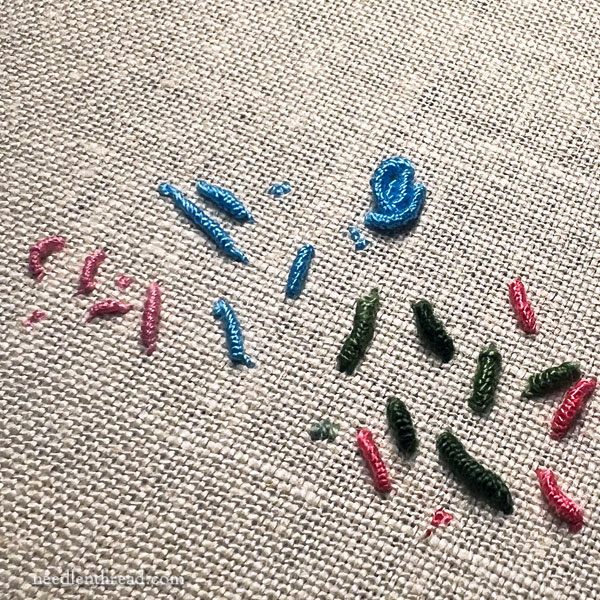I’ve been experimenting with a different, new-to-me method for making bullion knots.
It came about this way:
A couple inquiring minds directed me to a reel on Instagram and asked me to explain to them what was going on in the reel and what the resulting stitch was. They thought it looked like a bullion knot, but it didn’t seem to be made like a bullion knot.
Subtly, there’s more than one aspect to their question at work here, which I plan to explore further down the road. It will be fun to delve deep into all facets of their question, because without knowing it, they’re proposing a couple different really interesting topics related to embroidery stitches.

Three things prevent me from going deeper at the moment: 1. The constraint of space for one article on a multi-faceted subject; 2. the lack of demonstration photos (I’ll work on those!); and 3. the fact that – yeehaw and welcome to 2024! – I am dagblasted sick again, so I’m working from home with limited resources. I’ve been down and out since last Saturday. Thank goodness for Anna – she’s soldiering on at the studio front, far away from germy me.
In any case, their questions led me to experimenting. And to that end, I set up a frame with some fabric and starting doing what I saw in the reel – which was making bullion knots following a new-to-me method.
One of the difficulties with ever-popular social media reels is that, when it comes to embroidery, they are normally sped up, and sometimes they are sped up so much that you can’t really see clearly what’s going on.
And while they can be mesmerizing to watch, when it comes to reels – especially those that seem to be instructional – I fall somewhere in the camp of “they drive me nuts.” Good instruction, after all, doesn’t leave the viewer guessing.
There was a lot of starting and stopping as I watched the reel several times. And then, once the whole process in the video was clear in my head, I tried it. Then came practice, practice, practice.

And golly, wouldn’t you know? It was just like learning bullion knots all over again! Only worse. It took me a long time to get a few that I considered ok.
I found the method – which involved holding the needle away from the fabric and everything (including holding the needle and twisting the thread onto the needle) happening with one hand until the final movement of the stitch – awkward.
My results were consistently inconsistent, too! I’d work one and it would come out ok, and then I’d rejoice and say “Ok! I got it!”
Then I’d do it again, and the stitch would come out all wonky.

Still, just because I found it awkward doesn’t mean it is not a legitimate way to make bullion knots. I am pretty determined to keep trying it, to see if it will become less awkward with practice.
But I’ll tell you what: my tried and true bullion method of making bullion knots (tried and true to me, because I’m used to it, I guess) is pretty darned easy by comparison and the results are quite consistent.
I have a feeling it will remain my tried and true method, no matter what happens with my current exploits in bullion knot making.
I like to explore stitches, and it never hurts to see if there’s a better way to accomplish something!
We’ll cover more of this topic and explore some other aspects of it soon, at which time I’ll have more than just my phone pictures to share with you.
Coming Up!
We’re still on schedule for the launch of the kits for Purple Posy, our first Stitch Snippet stitch-along here on Needle ‘n Thread for 2024. If you want to join in on that, you can read more about it here.
There are a couple exciting books coming out shortly, and I’m looking forward to reviewing them for you soon.
Oh, and you know – other bits and bobs. We’ll look at a new linen or two that’s available for embroidery. That kind of fun stuff.
I’m looking forward to getting back to the studio, that’s for sure. See you soon!







Feel better.
Thanks, Helene! I’m working on it! 🙂
I’m sad to hear you are sick. I pray you have a speedy recovery!
Thanks, Jackie! It’s just that time of year, I reckon!
I’ll have to go find this reel, as I have only one functional hand and bullion knots are my nemesis. This one-handed version intrigues me!
Hi, Kimber – most of the process is one-handed, but the last part of the stitch requires two hands – one for tensioning and opening up the thread loop while the other passes the needle up into the fabric and through the thread loop to end the bullion in the same method as a chain stitch. The reel was from a Russian site, and I don’t have the original link. If I find it, I will email it to you, but I don’t like posting links to reels on my website for a wide variety of reasons, not least of which is that they can sometimes be associated with questionable social media accounts.
Thank you!
If you are watching a youtube video you can slow the speed down. Click on Settings in the lower right corner (the geared wheel), then choose Playback Speed. You can choose as slow as .25 to .75. You can even speed it up.
Yes, that’s a nice thing about regular online videos on YouTube and other video platforms. Social media reels don’t quite work the same way. You can’t really control any viewing options, except (thankfully!) being able to mute them, because they are often accompanied by music that doesn’t quite fit what you’re watching! LOL!
Very interesting. I do have that problem with video moving too quickly but photos seem to leave out something critical. I don’t take enough time to play with techniques in whatever thread or yarn work I am doing. You show me it isn’t time wasted.
I do hope you are feeling a little better each day.
Ellen
Mary, get well soon! I’ve never given a lot of thought to bullion knots and they always seemed to turn out fine, but my bullion knot standards may be on the lower side. Now I’m inspired to give them a little more attention and I can’t wait for this new, but not necessarily improved method of creating them.
Mary, have you tried slowing down the videos? GO to Settings-looks like a cog wheel (bottom right of the screen), Click on Playback Speed. I put this down to 0.5.
Love the way you do your version of bullion knots.
In Intagram?
Hope you feel better soon, Mary.
Can you provide the link to the video for the new to you bullion technique? Or provide more information so we can find it ourselves?
It was a reel on Instagram posted by a Russian account. The content on the account was somewhat questionable, when I looked at the account-holder’s page, and it was also associated with questionable advertising. This is why I didn’t link to it from my website. Unfortunately, I don’t have an Instagram user’s name, as it was entirely in Russian. It’s not an account I’d be comfortable giving multiple views to. But you can probably search on Instagram for bullion knot or bullion knot rose (that’s what she was making) and it may show up.
One problem I have with learning a new way to make a stitch – if I don’t like it better, I find myself floundering to relearn the original way. My brain wants to combine the methods and…that doesn’t work too well.
Hope you get over the crud soon!
Hi Mary 🙂 I have always thought that bullion knots looked like bugs, and couldn’t understand the attraction – until I tried one. Now I LOVE making them. But I’ve gotta say – yours (above) certainly look like a lot of bugs! I’ll look forward to your progress on this; if there’s a better way, I’m in.